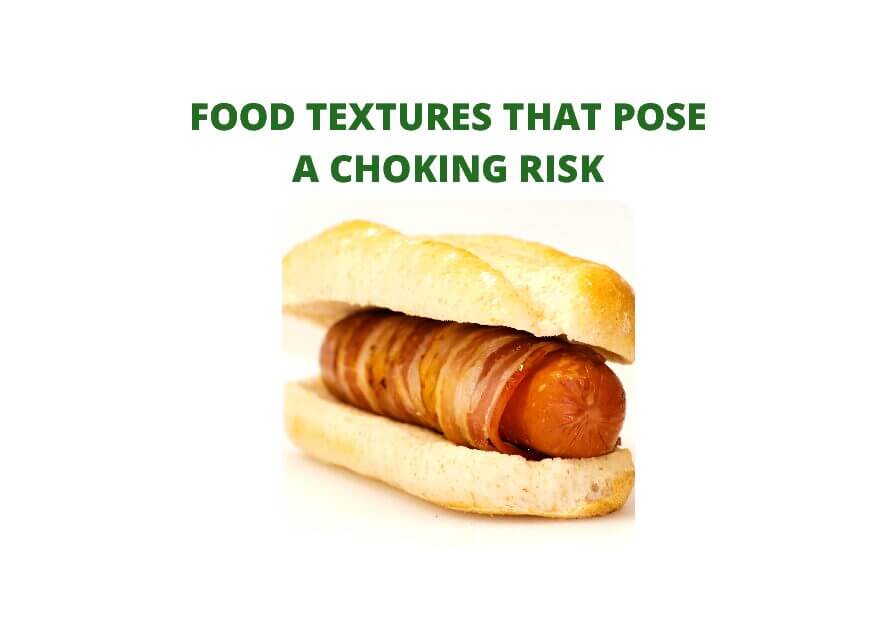Food Textures That Pose A Choking Risk
Food Textures That Pose A Choking Risk
When eating solid foods most people do not even think about chewing and swallowing their food. They put the food in their mouth, chew and then swallow. For some adults (and children) with chewing and swallowing difficulty, the act completing this task may be difficult. Chewing and swallowing is a very complex process. Numerous problems can occur and lead to choking or aspiration. The texture of foods can pose as an increased risk for choking for anyone. Many factors can increase the risk of choking. Individuals with chewing and / or swallowing difficulties have an increased risk of choking. Some food textures have been identified as presenting to a greater risk for choking. Individuals with dysphagia should avoid these textures to prevent a choking incident.
Crispy Textures
Crispy textures require good chewing a to break down foods in the mouth. Reduced chewing and swallowing abilities can present as a choking risk with crispy texture foods. Crispy foods have a firm and brittle surface. Examples : crisp bacon, some dry cereal, crispy pretzels, crispy biscuits, crispy crackers, crispy wontons, crispy chicken.

Skins, Husks or Outer Shells
Skins, husks or outer shells require good chewing ability to break down because they are often fibrous, spiky or dry. Adequate salvia is required to make moist or enough skill to remove pieces from areas in the mouth. Small pieces can become stuck to teeth and gums. The small pieces could catch in the throat when swallowed. Examples include : grape skins, husks, skins (like potato, cucumber, or apple) bran, psyllium.
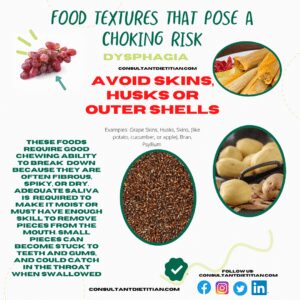
Bones, Shells or Gristle
Bones, shells and gristle are not usually chewed and swallowed. Bone and gristle is hard and not easy to chew. Individuals may not have adequate tongue or hand strength skill to remove the food from the bone shell or gristle. Examples: Bones or gristle from meat, chicken, or fish. Skin from Poultry or Seafood. Shells from seafood or eggs. No tough or outer casing on sausages or hot dogs.
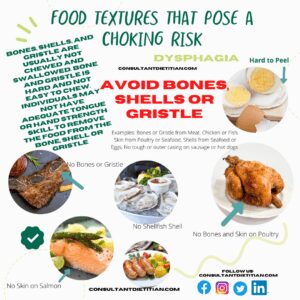
Crumbly Textures
Crumbly textures require good tongue control to bring pieces together and adequate salvia to hold the food together to facilitate an easy swallow. Examples: dry cakes, dry cookies , dry biscuits, scones, crumbly pies, crumbly donuts, coconut shrimp.
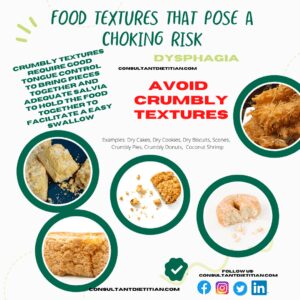
Crunchy Textures
Crunchy textures require good chewing ability and a sustained chewing ability to break down food into small particles to mix with saliva. Crunchy foods make a crunchy sound when pressed. Examples: potato chips, raw carrots, popcorn, raw apple, crunchy taco shells.

Fibrous or Tough Textures
Fibrous and tough textures require good chewing ability to break down . Fibrous and tough foods require a sustained chewing ability to make them safe for swallow. Examples: Tough steak, stringy meats, pineapple, chives, green onions, fibrous asparagus ends, unripe mango.
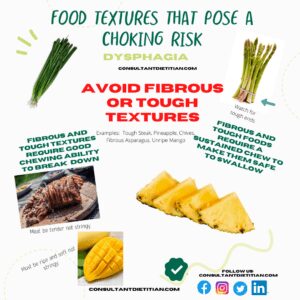
Gummy, Chewy or Sticky
Gummy, chewy or sticky good chewing ability to break down and moisten with saliva. Chewy, gummy and textures can become stuck to the roof of the mouth, teeth or cheeks and fall into the airway. Examples: Nut or Peanut Butter, Gummy Oatmeal or Mashed Potatoes, Rubbery Gelatin, Gummy, Candy Konjac containing jelly.
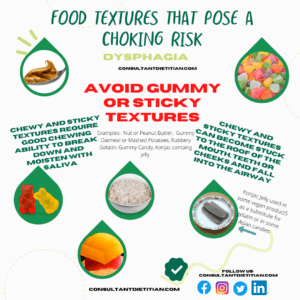
Hard or Dry Textures
Hard and dry textures require good chewing ability to break down. Dry textures require extra saliva to make them safe. to swallow. Examples: Nuts, Dry bread, Hard Crusty Rolls, Raw Carrots, Rice Cakes.

Long or Round Shapes
Long and round shapes must not be served to dysphagia patients, They pose a high risk for choking. If the long and round shapes are not properly chewed they can completely, block the airway. Examples, Hot dogs, Raw Apple Chunks, Sausages, Grapes, Raw Carrots.

Spiky or Sharp Textures.
Spiky or sharp textures require good chewing ability and adequate salvia to break down the food into small, soft, rounded pieces that moist enough to facilitate an easy swallow. Examples: Spiky corn chips, French Fries with sharp edges, over cooked roasted vegetables with sharp edges, over cooked corners of food. (lasagna or macaroni and cheese with sharp edges).
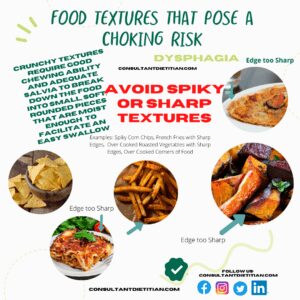
Stringy Textures
Stringy textures requires good chewing ability. Stringy foods can be difficult to breakdown and may get caught between the mouth and throat. Examples: Raw Celery, Rhubarb, Coconut, Sprouts, Pulled Meats, Chives, String Salad Greens, Artichokes, Onion Rings, Parsley, Green Onions.
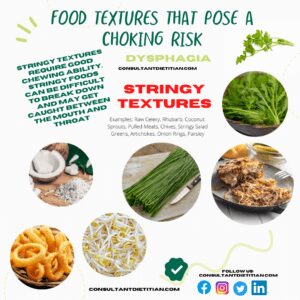
Sticky or Chewy Textures
Chewy and Sticky textures require good chewing ability to break down. Chewy and Sticky Textures can become stuck to the roof of the mouth, teeth or cheeks and fall into the airway. Examples: Sticky Candies, Caramels, Lollipops, Granola Bars, Dried Fruits, Marshmellows, Cheese Chunks, Chewing Gum, Sticky Mashed Potatoes.

The speech language pathologist can determine which food textures should be avoided.
Always seek medical advice from you doctor before changing your diet.
Source: iddsi.org
© The International Dysphagia Diet Standardisation Initiative 2019 @ https://iddsi.org/framework. Licensed under the CreativeCommons Attribution Sharealike 4.0 License https://creativecommons.org/licenses/by-sa/4.0/legalcode. Derivative works extending beyond language translation are NOT PERMITTED.
This site is NOT the official IDDSI website

